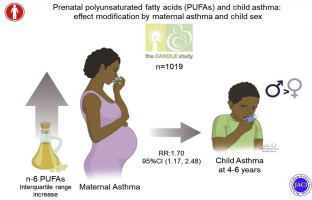当前位置:
X-MOL 学术
›
J. Allergy Clin. Immunol.
›
论文详情
Our official English website, www.x-mol.net, welcomes your
feedback! (Note: you will need to create a separate account there.)
Prenatal polyunsaturated fatty acids and child asthma: Effect modification by maternal asthma and child sex.
Journal of Allergy and Clinical Immunology ( IF 11.4 ) Pub Date : 2019-12-03 , DOI: 10.1016/j.jaci.2019.10.039 Maria José Rosa 1 , Terryl J Hartman 2 , Margaret Adgent 3 , Kourtney Gardner 4 , Tebeb Gebretsadik 5 , Paul E Moore 6 , Robert L Davis 7 , Kaja Z LeWinn 8 , Nicole R Bush 9 , Frances Tylavsky 10 , Rosalind J Wright 11 , Kecia N Carroll 3
Journal of Allergy and Clinical Immunology ( IF 11.4 ) Pub Date : 2019-12-03 , DOI: 10.1016/j.jaci.2019.10.039 Maria José Rosa 1 , Terryl J Hartman 2 , Margaret Adgent 3 , Kourtney Gardner 4 , Tebeb Gebretsadik 5 , Paul E Moore 6 , Robert L Davis 7 , Kaja Z LeWinn 8 , Nicole R Bush 9 , Frances Tylavsky 10 , Rosalind J Wright 11 , Kecia N Carroll 3
Affiliation

|
BACKGROUND
Findings on prenatal polyunsaturated fatty acid (PUFA) intake and child wheeze and asthma have been inconsistent.
OBJECTIVE
We sought to examine associations between prenatal PUFA status and child wheeze/asthma and modifying effects of maternal asthma/atopy, child sex, and maternal race.
METHODS
Analyses included 1019 mother-child dyads with omega-3 (n-3) and omega-3 (n-6) PUFAs measured in second-trimester plasma; n-6/n-3 ratios were calculated. Child wheeze/asthma outcomes ascertained at age 4 to 6 years included ever physician-diagnosed asthma, current wheeze (symptoms past 12 months), current asthma (diagnosis and medication and/or symptoms past 12 months), and current diagnosed asthma. Each PUFA indicator and outcome was analyzed in separate models using modified Poisson regression with interaction terms.
RESULTS
In quartile (Q) analyses, higher n-6 PUFAs were associated with increased risk of ever (risk ratio [RR] high vs low [RR Q4 vs Q1], 1.70; 95% CI, 1.07-2.71) and current (RR Q4 vs Q1, 1.70; 95% CI, 1.07-2.71) diagnosed asthma, whereas n-3 PUFAs were associated with lower risk (RR Q4 vs Q1, 0.59; 95% CI, 0.33-1.03) of current diagnosed asthma (Ptrend < .05 for all). Higher n-6 PUFAs were associated with a higher risk of all respiratory outcomes among children born to women with asthma (Pinteraction < .05 for all outcomes). A significant 3-way interaction between child sex, maternal asthma, and n-6/n-3 PUFA indicated that male children born to women with asthma and a higher ratio had the highest risk across wheeze/asthma outcomes (Pinteraction < .05).
CONCLUSIONS
Associations between prenatal PUFA status and childhood wheeze/asthma were modified by maternal history of asthma and child sex.
中文翻译:

产前多不饱和脂肪酸与儿童哮喘:母体哮喘和儿童性别的作用改变。
背景技术关于产前多不饱和脂肪酸(PUFA)摄入量和儿童喘息和哮喘的发现一直不一致。目的我们试图检查产前PUFA状态与儿童喘息/哮喘之间的关联,以及改变母体哮喘/体型,儿童性别和母体种族的影响。方法分析包括1019个母子双胞胎,其在孕中期血浆中测得了omega-3(n-3)和omega-3(n-6)PUFA。计算n-6 / n-3比率。在4至6岁时确定的儿童喘息/哮喘结局包括医生诊断过的哮喘,当前喘息(12个月以上的症状),当前哮喘(12个月以上的诊断和用药和/或症状)以及当前确诊的哮喘。使用修正的Poisson回归和交互作用项,在单独的模型中分析了每个PUFA指标和结果。结果在四分位数(Q)分析中,较高的n-6 PUFA与曾经患病风险(风险比[RR]高与低[RR Q4 vs Q1],1.70; 95%CI,1.07-2.71)和当前风险(RR)相关Q4 vs Q1,1.70; 95%CI,1.07-2.71)被诊断为哮喘,而n-3 PUFA与当前诊断为哮喘的风险较低(RR Q4 vs Q1,0.59; 95%CI,0.33-1.03)(Ptrend < .05(所有)。哮喘女性所生儿童中,n-6 PUFA较高与所有呼吸结果风险较高相关(所有结果的交互作用<0.05)。儿童性别,孕产妇哮喘和n-6 / n-3 PUFA之间存在显着的三向相互作用,表明患有哮喘的女性和比例较高的男孩所生的喘息/哮喘结局风险最高(相互作用<.05) 。
更新日期:2019-12-04
中文翻译:

产前多不饱和脂肪酸与儿童哮喘:母体哮喘和儿童性别的作用改变。
背景技术关于产前多不饱和脂肪酸(PUFA)摄入量和儿童喘息和哮喘的发现一直不一致。目的我们试图检查产前PUFA状态与儿童喘息/哮喘之间的关联,以及改变母体哮喘/体型,儿童性别和母体种族的影响。方法分析包括1019个母子双胞胎,其在孕中期血浆中测得了omega-3(n-3)和omega-3(n-6)PUFA。计算n-6 / n-3比率。在4至6岁时确定的儿童喘息/哮喘结局包括医生诊断过的哮喘,当前喘息(12个月以上的症状),当前哮喘(12个月以上的诊断和用药和/或症状)以及当前确诊的哮喘。使用修正的Poisson回归和交互作用项,在单独的模型中分析了每个PUFA指标和结果。结果在四分位数(Q)分析中,较高的n-6 PUFA与曾经患病风险(风险比[RR]高与低[RR Q4 vs Q1],1.70; 95%CI,1.07-2.71)和当前风险(RR)相关Q4 vs Q1,1.70; 95%CI,1.07-2.71)被诊断为哮喘,而n-3 PUFA与当前诊断为哮喘的风险较低(RR Q4 vs Q1,0.59; 95%CI,0.33-1.03)(Ptrend < .05(所有)。哮喘女性所生儿童中,n-6 PUFA较高与所有呼吸结果风险较高相关(所有结果的交互作用<0.05)。儿童性别,孕产妇哮喘和n-6 / n-3 PUFA之间存在显着的三向相互作用,表明患有哮喘的女性和比例较高的男孩所生的喘息/哮喘结局风险最高(相互作用<.05) 。









































 京公网安备 11010802027423号
京公网安备 11010802027423号